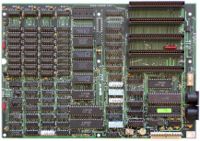Difference between revisions of "IBM 5150"
m |
|||
| Line 1: | Line 1: | ||
| − | The IBM 5150 was IBM's entry into the personal computer marketplace, the IBM PC. The original configuration was for 64kb of ram, and a tape drive, but could be expanded to include a diskette drive, and a hard disk. Back then, both types of disk drives were of the 5 1/4" full height form factor. | + | [[Image:IBM 5150.jpg|thumb|right|200px|The IBM PC]] |
| + | |||
| + | The IBM 5150 was IBM's entry into the personal computer marketplace, the IBM PC. The original configuration was for 64kb of ram, and a tape drive, but could be expanded to include a diskette drive, and a hard disk. Back then, both types of disk drives were of the 5 1/4" full height form factor. IBM made the PC an open standard, publishing not only schematics, but also including a BIOS listing in the technical reference. When people wished to build clones of the IBM PC, IBM would license them for a 5% royalty fee, which not only made the PC a popular platform to clone, but also with the available schematics, allowed for everyone to be pin compatible with the ISA slots, creating a thriving hardware expansion business. | ||
| + | |||
| + | The IBM PC included Microsoft BASIC in ROM, which allowed the PC to function like many of the computers of the time with a simple ROM BASIC. With the addition of a disk drive, OS options included [[CP/M]] and [[MS-DOS]] at the time of sale. | ||
The IBM PC, also established the 8 bit expansion slot, or [[ISA]] bus standard. | The IBM PC, also established the 8 bit expansion slot, or [[ISA]] bus standard. | ||
Revision as of 14:12, 4 August 2010
The IBM 5150 was IBM's entry into the personal computer marketplace, the IBM PC. The original configuration was for 64kb of ram, and a tape drive, but could be expanded to include a diskette drive, and a hard disk. Back then, both types of disk drives were of the 5 1/4" full height form factor. IBM made the PC an open standard, publishing not only schematics, but also including a BIOS listing in the technical reference. When people wished to build clones of the IBM PC, IBM would license them for a 5% royalty fee, which not only made the PC a popular platform to clone, but also with the available schematics, allowed for everyone to be pin compatible with the ISA slots, creating a thriving hardware expansion business.
The IBM PC included Microsoft BASIC in ROM, which allowed the PC to function like many of the computers of the time with a simple ROM BASIC. With the addition of a disk drive, OS options included CP/M and MS-DOS at the time of sale.
The IBM PC, also established the 8 bit expansion slot, or ISA bus standard.
The PC was replaced by the wildly popular IBM XT.

